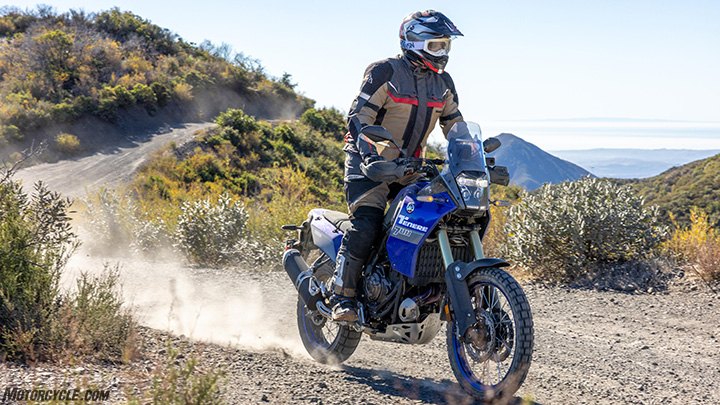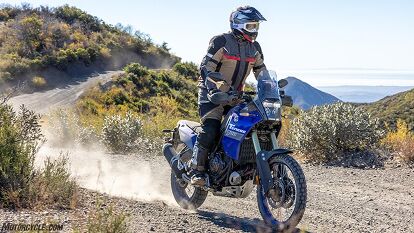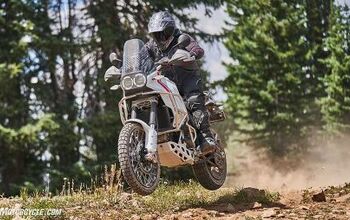2024 Yamaha Ténéré 700 First Ride

Small updates keep the T7 fresh, but we're still missing out on the European variants
Yamaha’s popular Ténéré 700 “T7” adventure bike returns for 2024, and while it would be easy to say it is “largely unchanged” from the 2023 model, there have been some notable changes made in response to feedback from many North American riders. One wish still unrealized: the U.S. dealers won’t be getting the up-spec World Raid and numerous other versions of the T7 the EU enjoys - at least not this year. But might that change?
Motorcycle.com was recently in sunny southern California to take the 2024 iteration for a day-long ride both on and off-pavement through the Santa Ana Mountains east of L.A. towards Lake Elsinore, and then down the twisting Ortega Highway back into LaLa land. The ride was based out of Yamaha’s sprawling facility in the Cypress section of Los Angeles.
2024 Ténéré 700 Feature Overview
From the “ain’t broke” list, much of the Ténéré’s best-loved features are indeed back for ‘24, including the reliable and flexible 689cc CP2 P-twin engine, which makes 64-ish horsepower and 44 pound feet of torque. Even with a stock exhaust, the twin hums a punchy tune thanks to its R1-inspired crossplane architecture and 270-degree firing order. The six-speed gearbox also returns unchanged, as does the 4.2-gallon fuel capacity.
The adjustable KYB legs are back as well, with 8.3 inches of travel for the 21-inch front wheel and 7.9 inches for the 18-inch rear hoop. The rear monoshock features a quick-adjust preload knob riders can turn by hand, while compression and rebound damping adjustments require a flat-head screwdriver. Yamaha’s choice of Pirelli Scorpion Rally STR tires strike a nice balance between street grip and off-road bite, and the dual 282mm Brembo front disc brakes impart reliable, progressive stopping power. A 245mm rear disc slows things down out back.
Other signature “T7” bits like the familiar rally-style quad LED headlight array are still in play, but there are some notable new features as well. Turn the key and the new (to the U.S.) color TFT display comes to life. It retains its vertical format like the old panel, which while useful, looked like it was rocking LCD display tech from about 1983. The new and much more modern color display features two display modes, Street and Explorer, with the latter nicely updating the original “rally” mode, and Street mode showing a more traditional type of layout with a round tachometer and data bits below. Both modes show speed, engine rpm, gear selection, air temperature, coolant temperature, fuel level, odometer, two trip meters, fuel economy data and more, including the time. So far, the display will not show GPS maps or prompts.
The 2024 T7 will also commiserate with Yamaha’s “Y-Connect” app via your smartphone and Bluetooth, with icons on the TFT panel showing an incoming phone call - or a missed call. It will also show if the rider received an email or text message, but it will not show the contents of the message on the screen. Screen display options and info are controlled by your thumb and a small click wheel in the right bar pod, but most bits are only adjustable while stopped.
Another feature for 2024 is more control over ABS. The older bikes allowed ABS to be turned off, but the new update allows three choices: all on, rear wheel off only, or no ABS at all, an option that is rare but welcome by some riders. Speaking of options, an upshift-only clutchless quick shifter is now available for $199 and our press bikes were all fitted with the device.
The 2024 T7 also features new LED turn signals which also function as always-on marker lights up front, but the signals themselves seem highly vulnerable to damage in a tipover, which seems very possible, if not likely, considering the bike’s off-road capabilities. However, all riders stayed upright on our press ride so it’s not yet known exactly how sturdy the new blinkers are.
Ride Time
Once familiarized with the new features and suited up for action, we plunged into Los Angeles traffic and headed east into the mountains on Highway 22. Lane splitting is legal in California, and we made good use of it.
Outside of the big city, we cut through some small burgs and finally exited the pavement. We aired down the tires a bit and switched off rear ABS only before heading further off road, and soon enough we were climbing a rocky dirt road to the broadcast antennas positioned high above the metropolis.
The roads were dry and dusty, with patches of deep silt and omnipresent loose rocks that banged loudly as they bounced into the skid plate. Water bars had created numerous g-outs and sharp rises along the road, which the T7 handled without breaking a sweat. Some riders were catching a fair bit of air off some of the humps in the road, but as I am recovering from a torn hamstring, my hang times were not very impressive.
What was impressive was the ease of riding the T7 through the rough stuff. At 460 pounds wet (and without any additional ADV gear added) the Tenere is definitely an adventure bike, not a dual-sport. That didn’t stop some riders in the group, including former motocross and supercross champions Damon Bradshaw and Ryan Villopoto, from getting some scary air off the many rises in the road and generally riding the T7 in a manner far beyond the capabilities of most everyone else in the group. But it was certainly nice to see what it was capable of in the hands of much more experienced riders.
After several hours on dirt roads that wove through the Fremont National Forest outside of Los Angeles, we made our way down Main Divide, a curling paved road that overlooked famed Lake Elsinore, and eventually connected to the Ortega Highway. We hustled the Ténéré down from elevation along the twisting two-lane Ortega as the December sun began to dip towards the Pacific ocean, and then merged with traffic on Interstate 5 for a high-speed blast back to Yamaha’s sprawling facility in Cypress.
Conclusions
Having ridden the Ténéré 700 several times over the past few years, it’s easy to understand its ongoing appeal. From adventure riders wanting to pick their way down remote singletrack to open road veteran Iron Butt riders such as Paul Pelland, better known as Long Haul Paul, who rode his highly customized T7 from his New Hampshire home to join the ride - and then rode back - the T7 is a true one-bike solution for most types of riding.
Balanced, comfortable, reliable, capable on road and off, it’s also plenty fast for real-world riding. We saw peeks at triple digits during some naughty behavior on an empty stretch of interstate, with more to go.
What’s not to like? With the updates for 2024, most things riders have been asking for have been addressed, although cruise control would be a nice addition. Really, only the fact that the North American market doesn’t get all those tasty variants our friends in Europe and elsewhere get to choose from is the biggest complaint.
But we wonder how long that situation will last. The Ténéré 700 has enjoyed middleweight adventure bike market popularity if not outright domination for several years now, prompting other brands to launch competitors including the Aprilia Toureg 660, Husqvarna Norden 901, and others. But now, it’s game on with juggernaut Honda and its reborn Transalp 750, which offers more horsepower (90), more torque (55lb-ft), more tech including five ride modes and a base price of $9,999, which undercuts the T7’s $10,700 price tag. Plus, well, it’s a Honda, so the chances of it coming up short against any similarly priced competition is slim.
Indeed, it could be a competitive cycle that benefits riders for years to come. It’s speculation but the success of the Ténéré 700 likely prodded Honda to get the Transalp to market. If it is successful (likely), Yamaha may feel pressure to respond in kind to bring some of those upgraded and updated Euro-spec T7s to the North American market.
Here’s hoping.
2024 Yamaha Ténéré 700 Specifications | |
|---|---|
MSRP | $10,799 |
Engine Type | 689cc liquid-cooled DOHC 4-stroke; 8 valves |
Bore x Stroke | 80.0mm x 68.6mm |
Compression Ratio | 11.5:1 |
Fuel Delivery | Fuel Injection |
Transmission | 6-speed; wet multiplate clutch |
Final Drive | Chain |
Front Suspension | 43mm inverted fork, fully-adjustable; 8.3 inches of travel |
Rear Suspension | Single shock, adjustable preload (w / remote adjuster) and rebound damping; 7.9 inches of travel |
Front Brakes | Dual 282mm hydraulic disc; selectable ABS |
Rear Brakes | 245mm hydraulic disc; selectable ABS |
Front Tire | 90/90R21 Pirelli Scorpion Rally STR |
Rear Tire | 150/70R18 Pirelli Scorpion Rally STR |
Length | 93.3 inches |
Width | 35.6 inches |
Height | 57.3 inches |
Seat Height | 34.4 inches |
Wheelbase | 62.8 inches |
Rake / Trail | 27° / 4.1 inches |
Ground Clearance | 9.4 inches |
Fuel Capacity | 4.2 gallons |
Wet Weight | 452 pounds (claimed) |
Warranty | Warranty 1 Year (Limited Factory Warranty) |
Become a Motorcycle.com insider. Get the latest motorcycle news first by subscribing to our newsletter here.

Motorcycle, tech and travel journalist, based in Portland, Oregon.
More by William Roberson


























































Comments
Join the conversation
This is surely a wonderful motorcycle. I rode a high mileage bike of the previous generation and thought it had a lot of potential. Too bad the ABS resets to road mode every time you cycle the power.